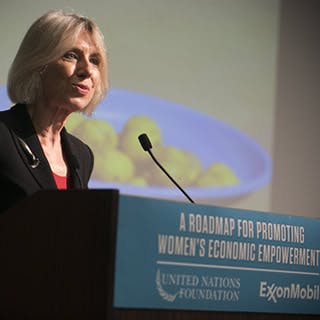 Last week, leaders from around the world gathered for the World Economic Forum in Davos to discuss the state of the global economy and outline priorities moving forward. To talk about progress for our global economy, we have to talk about progress for women, 50% of the population. That’s why I sat down with Mayra Buvinic, Senior Fellow at the UN Foundation, to discuss what we can do to spur economic empowerment for women globally.
Last week, leaders from around the world gathered for the World Economic Forum in Davos to discuss the state of the global economy and outline priorities moving forward. To talk about progress for our global economy, we have to talk about progress for women, 50% of the population. That’s why I sat down with Mayra Buvinic, Senior Fellow at the UN Foundation, to discuss what we can do to spur economic empowerment for women globally.
Katherine Brandon: When we talk about the global economy, why is women’s economic empowerment so important?
Mayra Buvinic: For many reasons! First, it is the right thing to do. Women should have equal opportunities in the labor market. But it’s also the smart thing to do: There is now substantial evidence that women’s economic empowerment is a powerful way to reduce poverty in developing countries and to promote economic growth. Finally, and perhaps most consequentially, by empowering women and girls, you are changing norms about what women and girls can do. It changes the value of women in conservative countries, which some studies have shown results in increased family investments in young girls.
KB: But until recently, there was a substantial research gap on what works best to economically empower women and girls.
MB: There’s been a lot of recent interest in women’s economic empowerment from both the public and private sectors. That interest has translated into important work on trying to explain the causes of gender inequality. But until our report, A Roadmap for Economic Empowerment, done in collaboration with the ExxonMobil Foundation, there had been little work on how we can actually change the situation. What can be done to empower women economically? This is the first report to look at this question systematically using rigorous evidence. We asked: What works best, for whom, and in different economic contexts?
KB: What did the report find?
MB: The main message of the report is that one size does not fit all. What may work for some women does not work for others.
One of the things that does appear to work for most women is savings. Individual savings, more than loans and access to capital in general, makes a big difference for women. There should be a lot more interest in providing savings products for women.
Secondly, information technologies, particularly mobile phones, help women tremendously. They help overcome social and family constraints that women face, such as the ability to conduct transactions privately.
Finally, we saw that for poor and very poor women, we really need to do more. One intervention alone is not going to make a big difference in providing opportunities for these women. It’s a sobering message: If you want to elevate the economic status of very poor women, we need to make greater investments. These investments pay off, but you have to be willing to utilize additional resources.
KB: What are the next steps?
MB: We need to continue to test these findings. But for the nine proven interventions we found that really do work, these need to be scaled up to have a significant impact.
KB: Finally, let’s say we’re at Davos in 2030. How does the world look differently for women?
MB: Hopefully, there would be more diversity in the people who attend Davos. And if the message of our report is taken seriously, what you would see is that women at the very bottom will have expanded opportunities, driving down global poverty rates quite dramatically. By expanding opportunities for women, we will reduce extreme poverty, decrease inequality, and spur economic growth. In 15 years, we would see more equality in the world, and greater participation of women at Davos.
To learn more and read the full report, visit www.womeneconroadmap.org.



 View All Blog Posts
View All Blog Posts